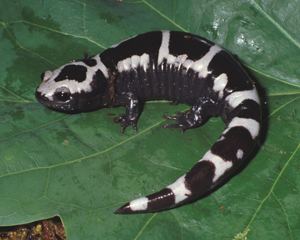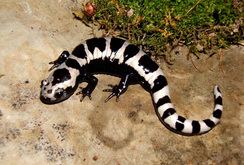Subphylum Vertebrata Order Caudata Scientific name Ambystoma opacum Rank Species | Phylum Chordata Subclass Lissamphibia Family Ambystomatidae Higher classification Mole salamander | |
 | ||
Similar Salamander, Mole salamander, Amphibians, Spotted salamander, Woodland salamander | ||
The marbled salamander (Ambystoma opacum) is a species of mole salamander found in the eastern United States.
Contents
A whole lot of marbled salamanders
Description
The marbled salamander is a stocky, boldly banded salamander. The bands of females tend to be gray, while those of males are more white. Adults can grow to about 11 cm (4 in), small compared to other members of its genus. Like most of the mole salamanders, it is secretive, spending most of its life under logs or in burrows.
Habitat and range

Marbled salamanders are found in the eastern United States, from southern New England to northern Florida, and west to Illinois and Texas. They have been found as far north as New Hampshire, though only two sightings have been reported there. Their habitats are damp woodlands, forests, and places with soft and wet soil. Seasonally flooded areas are essential for breeding, but the salamanders do not normally enter the water. They are not poisonous like many other salamanders.
Lifecycle

Adults spend most of their time in their burrows or under logs, as is the case with most mole salamanders. Juvenile marbled salamanders hatch early compared to most salamanders and gain a size advantage by feeding and growing for several months before the Jefferson salamanders and spotted salamanders hatch later in the spring. Larvae typically mature as quickly as two months in the southern part of their range, but take up to six months to mature in the northern part. Marbled salamanders, like other members of this genus, are reported to have relatively long life spans, 8–10 years or more.
Feeding

Adults take terrestrial invertebrates, such as worms, insects, centipedes, and mollusks (snails, slugs). Larvae take small aquatic animals (zooplankton), but larger individuals will take eggs and larvae of other amphibians, as well.
